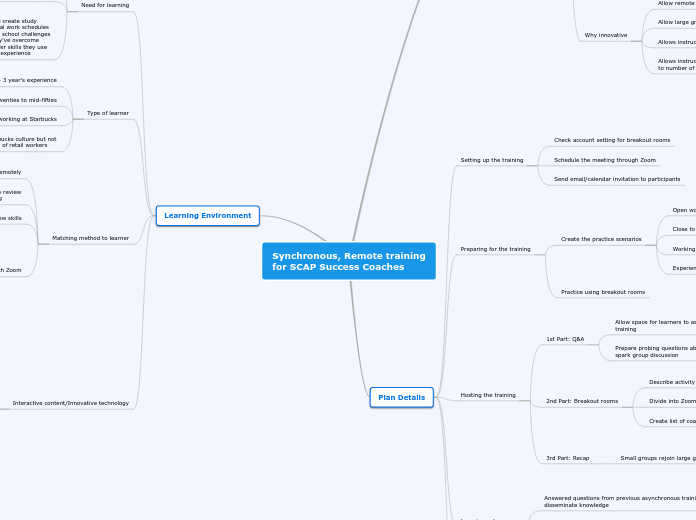Synchronous, Remote training
for SCAP Success Coaches
Learning Environment
Need for learning
Remote: follow up
from asynchronous training
Objective: ask questions,
discuss key takeaways,
practice with real-world scenarios
3 needs:
1) Better help students create study
schedules around typical work schedules
2) Help students relate school challenges
to work challenges they've overcome
3) Help students transfer skills they use
at work to their school experience
Type of learner
1 month - 3 year's experience
Age range: mid-twenties to mid-fifties
No practical experience working at Starbucks
Trained on Starbucks culture but not
daily experience of retail workers
Matching method to learner
Born out of necessity to train remotely
Time to meet synchronously to review
previous asynchronous training
Space to practice new skills
Familiarity with Zoom
Weekly team
meetings
Bi-weekly
development meetings
Professional development
webinars
Interactive content/Innovative technology
Focus on content since
delivery method is familiar
Three sections
Large group Q&A
Small group practice
Large group summary
Enhancing learning
Medium to ask questions
Space to disseminate learning
Space to practice learning
with peers
Rationale
Need
Globalizing economy
Global pandemic
Learning theories
Transformative learning
Social constructivism
Professional learning communities
Social cognition
Community of practice theory
Andragogy
Knowles' 5 assumptions
Pros of innovation
Space to ask questions from
asynchronous training
Distributed knowledge
Ability to practice
Cons of innovation
Zoom is not free
Limited accessibility from
Chromebook/Mobile
Breakout rooms not recorded
Scaled number of participants
per breakout room
Why innovative
Allow remote learners to engage synchronously
Allow large group to break into small groups for activity
Allows instructors to move between small groups
Allows instructors to assign number of breakout rooms
to number of practice scenarios
Plan Details
Setting up the training
Check account setting for breakout rooms
Schedule the meeting through Zoom
Send email/calendar invitation to participants
Preparing for the training
Create the practice scenarios
Open work availability disrupting study schedule
Close to losing benefits from hours worked
Working to promote internaly
Experiencing transitional leadership
Practice using breakout rooms
Hosting the training
1st Part: Q&A
Allow space for learners to ask questions from asynchronous training
Prepare probing questions about asynchronous training to spark group discussion
2nd Part: Breakout rooms
Describe activity to participants
Divide into Zoom breakout rooms with assigned scenario
Create list of coaching questions to ask student in scenario
3rd Part: Recap
Small groups rejoin large group to share
What was their scenario?
Top 2-3 favorite questions they created
Learning outcomes
Answered questions from previous asynchronous training - disseminate knowledge
Generate coaching questions for real-world scenarios
Use students' work experience to guide school experience
Without the technology
Learners would not have received real-time answer to previous training
Learners would not have been able to collaboratively generate coaching questions
Learners would not have been able to work synchronously to apply their learning to real-world scenarios
Learners would not have been able to share their generated questions, decreasing efficacy of asynchronous trianing
